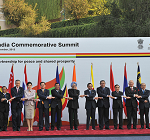The ASEAN-India Commemorative Summit, held on 20-21 December 2012 in New Delhi, which celebrated 20 years of ASEAN-India dialogue relations, was a success for Indian diplomacy in Southeast Asia. The heads of state or government of nine of the 10 ASEAN countries, as well as the vice-president of the Philippines, attended the summit.
The key points of the Vision Statement that emerged from the summit are: (1) The declaration of a strategic partnership between ASEAN and India; (2) The successful conclusion of the negotiations to extend the ASEAN-India Free Trade Agreement (FTA) to cover services and investments; (3) The agreement to expand connectivity between India and the ASEAN countries.
Indian officials were careful when asked by this author what it would mean to elevate the relationship between India and ASEAN to a strategic partnership. It’s a sensitive question. The partnership is not only a defence relationship, although ASEAN countries draw comfort from the fact that their western flank is buffered by India, a friendly power, and India feels comfortable with ASEAN as a shock absorber in the context of developing tensions further east, in the South China and East China Seas.
The concept of a strategic partnership, according to Indian officials, encompasses a wide range – economic exchanges; the fight against piracy and terrorism; cooperation in tackling pandemics; the ASEAN nations’ need for India as a neutral player helping them train their armed forces and as a source for the supply of spare parts and equipment for defence. These officials see the strategic partnership as an indication of the importance of ASEAN-India relations, and the deleterious consequences of allowing this relationship to falter – including a loss of confidence and a decline in trade and economic relations.
A significant achievement for India in the run-up to the Commemorative Summit was the conclusion of negotiations on extending the ASEAN-India FTA, already signed for trade in goods in 2003, to cover services and investments. India and the ASEAN countries had to overcome hesitations and fears about the impact of such an agreement on their domestic industries. Malaysia’s ability, as the coordinator, to push through the FTA, speaks of the importance all sides attach to this step. The governments of all ASEAN nations and India still have to pass legislation in their countries to enable the FTA to come into effect, but the conclusion of the negotiations is noteworthy.
Trade between India and the ASEAN countries has reached $80 billion in the financial year 2011-2012. The target in the Vision Statement, of reaching a total trade of $100 billion by 2015, seems feasible. As the statement points out, the ASEAN-India Free Trade Area covers 1.8 billion people with a combined GDP of $3.8 trillion.
India has also been invited to join the forthcoming negotiations on a Regional Comprehensive Economic Partnership. This grouping will include not only ASEAN countries but also China, Japan, Australia and Korea. With their divergent approaches to trade and capital flows, progress is likely to be slow.
In terms of next steps, Indian officials have emphasised the need for greater connectivity between India and the ASEAN countries. The Vision Statement talks of the India-Myanmar-Thailand trilateral highway, as well as plans to extend it to Laos and Cambodia and eventually to Vietnam. Committees have been set up in India to study, make recommendations and implement this connectivity, by, among other ways, drawing in private sector investment. However in this, as in other areas of economic exchanges with ASEAN, the steps taken by the Indian government to encourage private industry are small and hesitant.
The Vision Statement says everyone is “committed to promoting private sector engagement and encouraging business-to-business relations, including through establishing a necessary framework to strengthen private sector engagement and public-private partnership linkages.” But the Indian political leadership seems reluctant to play the same proactive role vis-à-vis Indian industry that other major powers have taken with their private industry and economic relations with ASEAN.
For example, U.S. Secretary of State Hillary Clinton not only attended the ASEAN Foreign Ministers Meeting in July 2012 in Phnom Penh, Cambodia, but simultaneously arranged for an ASEAN-wide U.S. CEOs meeting to be held in Siem Reap, where she invited Prime Minister Hun Sen. British Prime Minister David Cameron flew to Myanmar in April 2012 with leading businessmen for meetings with Myanmar’s new leaders and made it clear that he had come to promote British business interests. Japan’s new Prime Minister Shinzo Abe intends to visit Thailand, Indonesia and Vietnam along with representatives of Japanese industry. Thailand’s Prime Minister Yingluck Shinawatra also takes Thai businesses along with her on visits to neighbouring countries. So do other regional leaders, including those of Vietnam and Malaysia.
It is time for the Indian political leadership to play a similar active role in Southeast Asia. Without this enabling factor, Indian businesses will be left to fend for themselves in the important and competitive ASEAN region. The dynamism which can be injected into India-ASEAN relations through greater coordination of Indian private industry with government-to-government interactions, especially after the inclusion of services and investments in the FTA, will benefit all members of the regional partnership, including India.
Jesudas Bell is a former Indian diplomat, and has served in Indian Missions to Switzerland, Germany, Pakistan, Malaysia, Vietnam, Cambodia, and to the UN in New York. He is currently the CEO of Futurelinks International, which provides advisory services to infrastructure companies for projects and investments in South East Asia.
This article was exclusively written for Gateway House: Indian Council on Global Relations. You can read more exclusive content here.
For interview requests with the author, or for permission to republish, please contact outreach@gatewayhouse.in.
© Copyright 2013 Gateway House: Indian Council on Global Relations. All rights reserved. Any unauthorized copying or reproduction is strictly prohibited


